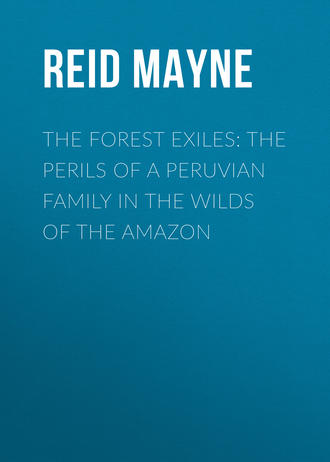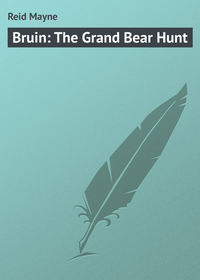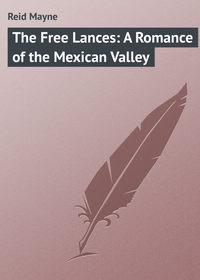 полная версия
полная версияThe Forest Exiles: The Perils of a Peruvian Family in the Wilds of the Amazon
That part of the body in sight was full as thick as a man’s thigh, and covered with black spots or blotches upon a ground of dingy yellow. It was seen to glisten as the animal moved, for the latter was in motion, crawling along the branch outward! The next moment its head appeared under the pendulous leaves; and its long forking tongue, protruding several inches from its mouth, seemed to feel the air in front of it. This tongue kept playing backwards and forwards, and its viscid covering glittered under the sunbeam, adding to the hideous appearance of the monster.
To escape from passing within its reach would be impossible. The balza was gliding directly under it! It could launch itself aboard at will. It could seize upon any one of the party without coming from the branch. It could coil its body around them, and crush them with the constricting power of its muscles. It could do all this; for it had crushed before now the tapir, the roebuck, perhaps even the jaguar himself.
All on board the boat knew its dangerous power too well; and, of course, terror was visible in every countenance.
Don Pablo seized the axe, and Guapo laid hold of his macheté. Doña Isidora, Leon, and the little Leona, were standing – fortunately they were – by the door of the toldo; and, in obedience to the cries and hurried gestures of Don Pablo and the Indian, they rushed in and flung themselves down. They had scarcely disappeared inside, when the forward part of the balza upon which stood Don Pablo and Guapo, came close to the branch, and the head of the serpent was on a level with their own. Both aimed their blows almost at the same instant; but their footing was unsteady, the boa drew back at the moment, and both missed their aim. The next moment the current had carried them out of reach, and they had no opportunity of striking a second blow.
The moment they had passed the hideous head again dropped down, and hung directly over, as if waiting. It was a moment of intense anxiety to Don Pablo. His wife and children! Would it select one as its victim, and leave the others? or —
He had but little time for reflection. Already the head of the snake was within three feet of the toldo door. Its eyes were glaring – it was about to dart down.
“Oh, God, have mercy!” exclaimed Don Pablo, falling upon his knees. “Oh, God!”
At that moment a loud scream was heard. It came from the toldo; and, at the same instant, the saimiri was seen leaping out from the door. Along with the rest, it had taken shelter within; but just as the head of the snake came in sight, a fresh panic seemed to seize upon it; and, as if under the influence of fascination, it leaped screaming in the direction of the terrible object. It was met halfway. The wide jaws closed upon it, its shrieks were stifled, and the next moment its silken body, along with the head of the anaconda, disappeared among the leaves of the mimosa. Another moment passed, and the balza swept clear of the branch, and floated triumphantly into the open water.
Don Pablo sprang to his feet, ran into the toldo, and, after embracing his wife and children, knelt down and offered thanks to God for their almost miraculous deliverance.
Chapter Forty One.
A Batch of curious Trees
Of course the escape from danger so imminent, after the first moments were over, produced a sort of reaction in the feelings of all, and they were now rather joyous than otherwise. But with all there was a mixture of regret when they thought of the fate of little “titi.” It had been their only pet, and had grown to be such a favourite that its loss was now mourned by every one, and its absence caused them to feel as though one of the company had been left behind. Several times during that day poor “titi” was the subject of conversation; indeed, they could hardly talk about anything else. Little Leona was quite inconsolable; for the pretty creature had loved Leona, and used to perch on her shoulder by the hour, and draw her silken ringlets through its tiny hand, and place its dainty little nose against the rich velvet of her cheek, and play off all sorts of antics with her ears. Many an hour did “titi” and Leona spend together. No wonder that the creature was missed.
During the whole of that day they travelled through a country covered with dense forest. The river was a full half-mile wide, but sometimes there were islands, and then the current became narrowed on each side, so that in passing, the balza almost touched the trees on one side or the other. They saw many kinds of trees growing together, and rarely a large tract covered with any one species of timber, for this, as already remarked, is a peculiarity of the Amazon forests. Many new and curious trees were noticed, of which Don Pablo gave short botanical descriptions to the others, partly to instruct them, and partly to while away the hours. Guapo, at the rudder, listened to these learned lectures, and sometimes added some information of his own about the properties of the trees, and the uses to which they were put by the Indians. This is what is termed the popular part of the science of botany, and, perhaps, it is more important than the mere classification of genera and species, which is usually all the information that you get from the learned and systematic botanists.
Among the trees passed to-day was one called the “volador” (gyrocarpus). This is a large forest tree, with lobed leaves, of a heart-shape. But it is the seeds which are curious, and which give to the tree the odd name of “volador,” or “flier.” These seeds have each a pair of membranaceous and striated wings, which, when the seeds fall, are turned to meet the air at an angle of 45 degrees; and thus a rotatory motion is produced, and the falling seeds turn round and round like little fly-wheels. It is altogether a curious sight when a large volador is shaken in calm weather, to see the hundreds of seeds whirling and wheeling towards the ground, which they take a considerable time in reaching. The volador is not confined to South America, I have seen it in Mexico, and other parts of North America.
Another singular tree noticed was a tree of the barberry family (berberis), known among the Spanish-Americans as barba de tigre, or “tiger’s beard.” This name it derives from the fact of its trunk – which is very large and high – being thickly set all over with sharp, branching thorns, that are fancied to resemble the whiskers of the jaguar, or South American “tiger.”
A third remarkable tree (or bush) observed was the Bixa orellana, which yields the well-known arnatto dye. This bush is ten or twelve feet in height, and its seeds grow in a burr-like pericarp. These seeds are covered with a reddish pulp, which produces the dye. The mode of making it is simple. The Indian women throw the seeds into a vessel of hot water, and stir them violently for about an hour, until they have taken off the pulp. The water is then poured off, and the deposit, separated from the seeds, is mixed with oil of turtle-eggs, or crocodile fat, and kneaded into cakes of three or four ounces weight. It is then “anoto,” sometimes written “arnatto,” sometimes “arnotto,” sometimes “onoto,” and sometimes “anato.” The first is the proper spelling. In Brazil it is called “urucu,” whence the French name “rocou;” and the Peruvians have still another designation for it, “achote.” Of course each tribe of Indians calls it by a separate name. The botanic name, Bixa, is the ancient name by which it was known to the Indians of Hayti, for it is found in most parts of tropical America growing wild, although it is also cultivated. It is an article in great demand among all the Indians of South America, who use it for painting their bodies, and dyeing the cotton cloth of which they make their garments.
But these people are very skilful in drawing pigments from plants and trees of many kinds; in fact, their practical chemistry, so far as it relates to dyes and poisons, is quite surprising, and from time to time Guapo pointed out trees that were used by them for such purposes.
One was a climbing plant, whose tendrils reached to the tops of the highest trees. It had beautiful violet-coloured flowers, an inch long, and Don Pablo saw that it was a species of bignonia. Guapo called it “chica.” When in fruit it carries a pod two feet in length, full of winged seeds. But Guapo said it was not from the seeds that the dye was obtained, but from the leaves, which turn red when macerated in water. The colouring matter comes out of the leaves in the form of a light powder, and is then shaped into cakes, which sell among the Indians for the value of a dollar each. This colour has a tinge of lake in it, and is prized even more highly than the anoto. Indeed, red dyes among all savage nations seem to hold a higher value than those of any other colour.
Another dye-tree was the “huitoc.” This one is a slender tree, about twenty feet high, with broad leaves shooting out from the stem, and nuts growing at their bases, after the manner of the bread-fruit. These nuts resemble black walnuts, and are of a russet colour outside; but the pulp inside, which produces the huitoc, is of a dark blue, or purple tint.
The “wild indigo tree,” was also seen growing in the woods, with a leaf narrow at the base, and broad at the extremity. With these and many other dyes the Indians of the Montaña paint their bodies in fantastic modes. So much are they addicted to these customs, that, among the Indians who labour at the missions, some have been known to work nearly a month to procure paint enough to give their body a single coat, and the missionaries have made a merchandise of this gigantic folly. But the paint is not always to be looked upon in the light of a mere folly, or vanity. Sometimes it is used to keep off the “zancudos,” or mosquitoes, so numerous and annoying in these regions.
Another singular tree was observed, which Guapo called the “marima,” or “shirt-tree.” The use of this he explained. The tree stands fifty or sixty feet high, with a diameter of from two to three. When they find them of this size, the Indians cut them down, and then separate the trunk into pieces of about three feet long. From these pieces they strip the bark, but without making any longitudinal incision, so that the piece of bark when taken off is a hollow cylinder. It is thin and fibrous, of a red colour, and looks like a piece of coarsely-woven sack-cloth. With this the shirt is made, simply by cutting two holes in the sides to admit the arms, and the body being passed into it, it is worn in time of rain. Hence the saying of the old missionaries, that in the “forests of America garments were found ready-made on the trees.”
Many other trees were noticed valuable for their fruits, or leaves, or bark, or roots, or their wood. There was the well-known “seringa,” or India-rubber tree; the great courbaril, the “dragon’s-blood” tree, not that celebrated tree of the East (Draccena), but one of a different genus (Crotori), from whose white bark flows a red blood-like juice.
They saw, also, a species of cinnamon-tree (Laurus cinnamonoides), though not the cinnamon of commerce; the large tree that bears the Brazilian nutmeg (the Puxiri); and that one, also, a large forest tree, that bears the nuts known as “Tonka beans,” and which are used in the flavouring of snuff.
But of all the trees which our travellers saw on that day, none made such an impression upon them as the “juvia,” or Brazil-nut tree (Bertholletia excelsa). This tree is not one with a thick trunk; in fact, the largest ones are not three feet in diameter, but it rises to a height of 120 feet. Its trunk is branchless for more than half that height, and the branches then spread out and droop, like the fronds of the palm. They are naked near their bases, but loaded towards the top with tufts of silvery green leaves, each two feet in length. The tree does not blossom until its fifteenth year, and then it bears violet-coloured flowers; although there is another species, the “sapucaya,” which has yellow ones. But it is neither the trunk, nor the branches, nor the leaves, nor yet the flowers of this tree, that render it such an object of curiosity. It is the great woody and spherical pericarps that contain the nuts or fruits that are wonderful. These are often as large as the head of a child, and as hard as the shell of the cocoa-nut! Inside is found a large number – twenty or more – of those triangular-shaped nuts which you may buy at any Italian warehouse under the name of “Brazil-nuts.”
Chapter Forty Two.
The Forest Festival
In consequence of their having rested but poorly on the preceding night, it was determined that they should land at an early hour; and this they did, choosing an open place on the shore. It was a very pretty spot, and they could see that the woods in the background were comparatively open, as though there were some meadows or prairies between. These openings, however, had been caused by fire. There had been a growth of cane. It had been burned off and as yet was not grown up again, though the young reeds were making their appearance like a field of green wheat. Some places, and especially near the river, the ground was still bare. This change in the landscape was quite agreeable to our travellers; so much so, that they resolved to exercise their limbs by taking a short stroll; and, having finished their late dinner they set out. They all went together, leaving the balza and camp to take care of themselves.
After walking a few hundred yards their ears were assailed by a confused noise, as if all the animals in the forest had met and were holding a conversazione. Some low bushes prevented them from seeing what it meant, but on pushing their way through, they saw whence and from what sort of creatures the noise proceeded.
Standing out in the open ground was a large and tall juvia-tree. Its spreading branches were loaded with great globes as big as human heads – each one, of course, full of delicious nuts. These were now ripe, and some of them had already fallen to the ground.
Upon the ground an odd scene presented itself to the eyes of our travellers. Between birds and animals assembled there, there were not less than a dozen kinds, all as busy as they could be.
First, then, there were animals of the rodent kind. These were pacas (Coelogenus paca), agoutis (Chloromys), and capivaras. The pacas were creatures a little larger than hares, and not unlike them, except that their ears were shorter. They were whitish on the under parts, but above were of a dark brown colour, with rows of white spots along each side. They had whiskers like the cat, consisting of long white bristles; and their tails, like those of hares, were scarcely visible. The agoutis bore a considerable resemblance to the pacas. Like these, they are also rodent animals, but less in size; and instead of being spotted, they are of a nearly uniform dark colour mixed with reddish brown. Both pacas and agoutis are found in most parts of tropical America. There are several species of each, and with the chinchillas and viscachas already described, they occupy the place in those regions that the hares and rabbits do in northern climates. Indeed, European settlers usually know them by the names of hare or rabbit, and hunt them in the same way. The flesh of most species is very good eating, and they are therefore much sought after both by the natives and colonists. Along with these, near the juvia-tree, were several capivaras, already noticed. But still more singular creatures on the ground were the monkeys. Of these there were different kinds; but that which first drew the attention of our party was the great Capuchin monkey (Brachyurus chiropotes). This creature is not less than three feet in height and of a reddish maroon colour. Its body is entirely different from the “ateles” monkeys, being stouter and covered with a fuller coat of hair; and its tail is large and bushy, without any prehensile power. It is, in fact, less of a tree monkey than the ateles, although it also lives among the branches. The most striking peculiarities of the Capuchin are its head and face. In these it bears a stronger resemblance to the human being than any other monkey in America. The top of its head is covered with a crop of coarse hair, that lies somewhat after the fashion of human hair; but, what most contributes to the human expression is a large full beard and whiskers reaching down to the breast, and arranged exactly after the fashion of the huge beards worn by Orientals and some Frenchmen. There were only two of these Capuchins on the ground – a male and female, for this species does not associate in bands. The female one was easily distinguished by her smaller size, and her beard was considerably less than that of the male. The beards seemed to be objects of special attention with both – especially the male, as every now and then he was observed to stroke it down with his hand, just as a dandy may be seen doing with his moustache or his well-brushed whiskers.
Another peculiar habit of the Capuchins was noticed. There was a little pool of water close by. Every now and then they ran to this pool and took a drink from it. But in drinking they did not apply their lips to the pool or lap like a dog. No; they lifted the water in the hollow of their hands – hence their specific name of chiropotes, or “hand-drinking monkeys.” They raised the water to their lips with great care, taking pains not to let a drop of it fall on their precious beards. From this habit of going so often to quench their thirst, the Capuchin monkeys have in some parts got the name of “hard-drinking monkeys.”
Apart from these was a troop of monkeys of a very different species. They were nearly of the same size, but more of the shape of the “ateles;” and their long tails, naked underneath and curling downward near the points, showed that, like them too, they possessed prehensile power in that member. Such was the fact, for they were “howling monkeys;” and some species of these can use the tail almost as adroitly as the “ateles” themselves. Those that our travellers saw were the “guaribas,” nearly black in colour, but with their hands covered with yellow hair, whence their name among the naturalists of “yellow-handed howler” (Stentor flavimanus). They were seated in a ring when first observed, and one – apparently the chief of the band – was haranguing the rest; but so rapid were his articulations, and so changeable the tones of his voice, that any one would have thought the whole party were chattering together. This, in effect, did occur at intervals, and then you might have heard them to the distance of more than a mile. These creatures are enabled to produce this vast volume of voice in consequence of a hollow bony structure at the root of the tongue, which acts as a drum, and which gives them the appearance of a swelling, or goitre, in the throat. This is common to all the howling monkeys as well as the guaribas.
Besides the howlers there were other species – there were tamarins, and ouistitis, and the black coaitas of the genus “ateles,” all assembled around the juvia-tree. There were parrots, and macaws, and other nut-eating birds. High above in the air soared the great eagle watching his opportunity to swoop down on the pacas or agoutis, his natural prey. It was altogether a singular assemblage of wild animals – a zoological garden of the wilderness.
Our party, concealed by bushes, looked on for some time. They noticed that not one of all the living things was under the tree. On the contrary, they formed – monkeys, cavies, parrots, and all – a sort of ring around it, but at such a distance that none of the brandies were above them! Why was this? Guapo knew the reason well, and before leaving their place of observation the others had an explanation of it.
While they stood gazing one of the great globes was seen to fall from the tree above. The loud report as it struck the earth could have been heard a long way off. It caused the whole assemblage of living creatures to start. The macaws flapped their wings, the monkeys ran outward and then stopped, and a simultaneous cry from the voices of both birds and beasts echoed on all sides; and then there was a general chattering and screaming, as though the fall of the great pericarp had given pleasure to all parties.
It was very evident from this circumstance why both beasts and birds kept so far out from the tree. One of these fruits coming down like a nine-pound shot would have crushed any of them to atoms. Indeed, so heavy are they, that one of them falling from a height of fifty or sixty feet will dash out the brains of a man; and the Indians who gather them go under the trees with great wooden helmets that cover both the head and shoulders! It would be no boy’s play to “go a nutting” in a wood of juvia-trees.
But how did the monkeys and birds get at the nuts? Neither of these could break open the outer shell. This is full half an inch thick, and so hard that it can scarcely be cut with a saw. How could either monkeys or birds open it? – that was the question put to Guapo.
“Watch them,” said Guapo.
All kept their eyes bent attentively on what was going on; and to their astonishment they observed that neither the monkeys nor the birds had anything to do with the opening of the shells. That was entirely the work of the rodent animals, the pacas, cavies, and agoutis. These with their fine cutting teeth laid open the thick pericarps, and whenever one was seen to have succeeded, and the triangular nuts were scattered upon the ground, then there was a general rush, and macaws, parrots, and monkeys scrambled for a share. The monkeys, however, did their part of the work. Whenever a fruit fell from the tree, one or two of them, deputed by the others, were seen to run in and roll it out, all the while exhibiting symptoms of great terror. They would then lift it in their hands, several of them together, and dash it repeatedly upon a stone. Sometimes, when the shell was not a strong one, they succeeded in breaking it in this way; but oftener they were not able, and then it was left to the rodent animals, who were watched at their operations, and usually robbed of the fruits of their labour. Such were the singular incidents witnessed at this festival of juvia-nuts.
But the scene was brought to a sudden termination. A cry was heard that rose far above all the other noises – a cry more terrible than the screams of the parrots, or the shrieks of the howling monkeys – it was the cry of the jaguar! It came from a piece of woods close to the juvia-tree, and the branches were heard to crackle as the dreaded utterer advanced.
In a moment the ground was cleared of every creature. Even the winged birds had flew up from the spot, and perched upon the branches; the cavies took to the water; the pacas and agouties to their burrows; and the monkeys to the tops of the adjacent trees; and nothing remained on the ground but the empty shells of the juvias.
Our party did not stay to notice the change. They, too, had been warned by the roar of the tiger, and hastily leaving the spot, returned to their place of encampment. On reaching it, they kindled a large circle of fire to keep them in safety during the night. They saw no more of the jaguar, although at intervals through the midnight hours, they were awakened by his loud and savage cry, resounding through the openings of the forest.
Chapter Forty Three.
Acres of Eggs
The next evening our travellers encamped on a sand-bar, or rather a great bank of sand, that ran for miles along one side of the river. Of course they had nothing to hang their hammocks to, but that was a matter of no importance, for the sand was dry and soft, and of itself would make a comfortable bed, as pleasant to sleep on as a hair-mattress. They only wanted wood enough to cook with, and to keep up their fire during the night – so as to frighten off the wild beasts.
This night they kept watch as usual, Leon taking the first turn. In fact, they found that they must do so every night – as in each of the camps where they had slept some danger had threatened; and they thought it would be imprudent for all to go to sleep at the same time. The heaviest part of the sentinel’s duty fell to Guapo’s share; but Guapo had long accustomed himself to go without sleep, and did not mind it; moreover Don Pablo took longer spells at the stern-oar during the day, and allowed Guapo many a “cat-nap.”









